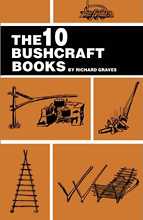How to Find Water (Finding Water in the Wilderness)
This page is taken from the 10 Bushcraft Books by Richard Graves.
Associated directly with food is water. These two are essential to life. Just as there is the problem of finding food in the bush, so too is there the problem of finding water, and many explorers and backwoodsmen died because they did not know how or where to look for water in apparently dry and arid regions.
This page contains the following sections:
Using Animals To Find Water
How To Find Water From Vegetable Sources
Other Methods You Can Use To Find Water
How To Purify Stagnant water
Using Animals To Find Water
Many different forms of life are certain indicators of water in the near vicinity. The bees must have water. The mason fly, that big yellow and black hornet-like creature, requires mud and water for the tunnel wherein he stores the spider he has paralysed. Pigeons and all grain eaters need water, but the flesh-eaters such as the crow and the hawks and eagles can go without water for long periods.
By knowing something of the nature of the insects, birds, animals and reptiles you can often find their hidden stores of precious water.
Bees 
Bees in an area are a certain sign of water. Rarely will you find a hive of wild bees more than three or four miles from fresh water. A bee flies a mile in 12 minutes. You can be sure that if you see bees you are not far from fresh water, but you will probably have to look for further indications before you actually find the water supply.
Ants 
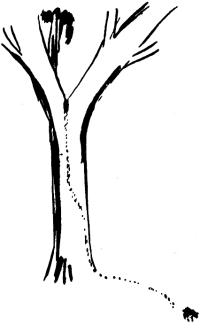 Many of the ants require water, and if you see a steady column of small black ants climbing a tree trunk and disappearing into a hole in a crotch it is highly probable that there will be a hidden reservoir of fresh water stored away there. Many of the ants require water, and if you see a steady column of small black ants climbing a tree trunk and disappearing into a hole in a crotch it is highly probable that there will be a hidden reservoir of fresh water stored away there.
This can be proved by dipping a long straw or thin stick down the hole into which the ants are going. Obviously if it is wet when you draw it out there is water there.
To get the water do not on any account chop into the tree. If the hole is only very small, enlarge it with your knife-point at the top. Make a mop by tying grass or rag to a stick. Dip the mop into the water and squeeze into a pannikin.
Another method is to take a long hollow straw and suck the water you require from the reservoir. These natural tree reservoirs are very common in dry areas, and are often kept full by the dew which, condensing on the upper branches of the tree, trickles down into the crotch and so into the reservoir inside the tree. Water reservoirs are very common in the she-oaks (casuarinas) and many species of wattle.
Mason flies 
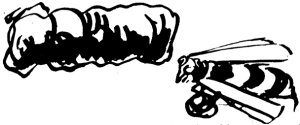 These large, hornet-like creatures are a certain indicator of water. If you see a mason fly's buildings in an area you can be sure that you are within a few hundred yards [metres] of a soak of wet earth.
These large, hornet-like creatures are a certain indicator of water. If you see a mason fly's buildings in an area you can be sure that you are within a few hundred yards [metres] of a soak of wet earth.
Search around carefully and you will see the mason fly hover and then suddenly drop to the ground. If you examine the place where she landed you will find the soil is moist, and that she is busy rolling a tiny pellet of mud for her building. By digging down a few inches (or at, most, a couple of feet) you will assuredly find a spring and clear, fresh, drinkable water.
Birds — Finches 
 All the finches are grain-eaters and water-drinkers. In the dry belts you may see a colony of finches and you can be certain that you are near water, probably a hidden spring or permanent soak.
All the finches are grain-eaters and water-drinkers. In the dry belts you may see a colony of finches and you can be certain that you are near water, probably a hidden spring or permanent soak.
Birds — Wild pigeons 
 Wild pigeons are a reliable indicator of water. Being grain and seed eaters they spend the day out on the plains feeding, and then, with the approach of dusk, make for a waterhole, drink their fill, and fly slowly back to their nesting places.
Wild pigeons are a reliable indicator of water. Being grain and seed eaters they spend the day out on the plains feeding, and then, with the approach of dusk, make for a waterhole, drink their fill, and fly slowly back to their nesting places.
Their manner of flight tells the experienced bushman the direction of their water supply. If they are flying low and swift they are flying to water, but if their flight is from tree to tree and slow, they are returning from drinking. Being heavy with water, they are vulnerable to birds of prey. It is obvious then that the direction of water can be discovered by observing the pigeons' manner of flight.
Birds — Grain eaters 
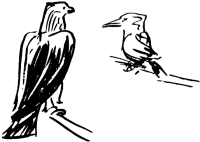 All the grain eaters and most of the ground feeders require water, so that if you see their tracks on the ground you can be reasonably certain that there is water within a few miles of your location. An exception to this are parrots and cockatoos, which are not regarded as reliable indicators of water.
All the grain eaters and most of the ground feeders require water, so that if you see their tracks on the ground you can be reasonably certain that there is water within a few miles of your location. An exception to this are parrots and cockatoos, which are not regarded as reliable indicators of water.
Birds — Flesh Eaters and Water Birds 
The carnivores, being flesh eaters, get most of the moisture they require from the flesh of their prey, and consequently are not reliable water-drinkers. Therefore, do not regard the presence of flesh-eating birds as an indicator of water in the area, nor should you regard the water living birds as indicators of fresh or drinkable water.
Mammals 
Nearly all mammals require water at regular intervals to keep themselves alive. Even the flesh eaters must drink, but animals can travel long distances between drinks, and therefore, unless there is a regular trail you cannot be confident of finding water where you see animals' trails. This is a general rule.

However, certain animals never travel far from water. For example, a fresh track of a wild pig is one sign that there is water in the vicinity, also the fresh track of 'roos and most of the grazing animals, whose habit it is to drink regularly at dawn or dusk. In general, water will be found by following these trails downhill.
Reptiles 
Most of the land-living reptiles are independent, to a very large extent, on water. They get what they require from dew and the flesh of their prey, and as a result are not an indicator of water in the area.
How To Find Water From Vegetable Sources
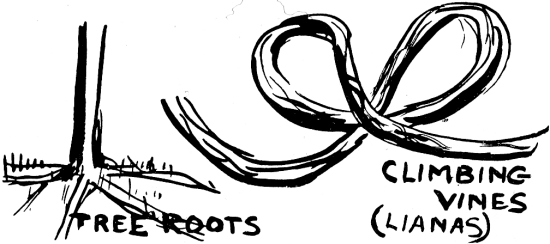
The roots and branches of many trees contain sufficient free-flowing fluid to relieve thirst, and this can be collected by breaking into 3 ft. lengths the roots or branches and standing these in a trough (of bark) into which the collected fluid will drain to the pannikin. In some plants the amount of water stored is truly unbelievable, the fluid literally gushing out when the plant is cut.
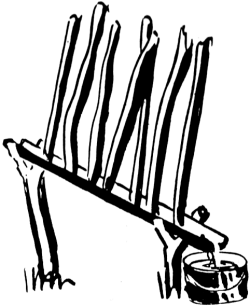 These vegetable "drinking waters" cannot be kept for more than twenty-four hours. The fluid starts to ferment or go bad if stored, and might be dangerous to drink if in this condition.
These vegetable "drinking waters" cannot be kept for more than twenty-four hours. The fluid starts to ferment or go bad if stored, and might be dangerous to drink if in this condition.
The nature of the plant, if judged by the properties of its foliage, is no guide to the drinkability of the fluids which are its sap.
Eucalypts (Gum Trees) 
For example, the eucalypts, whose leaves are heavily impregnated with oils of eucalyptus, and in many cases poisonous to human beings, contain a drinkable fluid, easily collected (from the branches or roots). This fluid is entirely free from the essential oils and with no taint of the eucalyptus.
Vines (Lianas, or Monkey Ropes) 
The lianas or monkey ropes found in tropical areas are an example of a prolific source of water.
There are certain precautions, and a few danger signs, with regard to vegetable fluids.
Plants With Milky Sap   
If the fluid is milky or coloured in any way, it should be regarded as dangerous, not only to drink but also to the skin. Many of the milky saps, except those of the ficus family, which contain latex, or a natural rubber, are extremely poisonous. The milky sap of many weeds can poison the skin and form bad sores, and if allowed to get into the eye may cause blindness and severe pain.
Taste Test The Water First
With all vegetable sources of fluid even though the water itself is clear, taste it first and, if quite, or almost, flavourless, it is safe to drink.
For vegetable sources of water in arid areas the best volume is generally obtained by scratching up the surface roots. They are discovered close to the ground, and if cut close to the tree, may be lifted and pulled, each root yielding a length of from ten to twenty feet. These must be cut into shorter lengths for draining.
Many people who have tried to obtain drinking water from vegetable sources failed to get the precious liquid to flow because they did not break or cut the stalk or root into lengths. Unless these breaks are made, the fluid cannot flow, and the conclusion is that the root, branch or vine is without moisture.
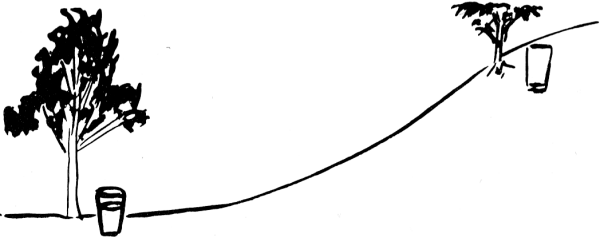
In general, water is more plentiful from plants in gullies than on ridges, and the flow is wasted if the roots are broken into sections and not cut. Cutting tends to bruise and seal the capillary channels. [Note: It seems to make more sense if the last sentence said "Breaking tends to bruise and seal the capillary channels"]
Other Methods You Can Use To Find Water
Dew collection
In barren areas where there are no trees, it may be possible to collect sufficient moisture from the grass in the form of dew, to preserve life. One of the easiest ways of dew collection is to tie rags or tufts of fine grass round the ankles and walk through the herbage before the sun has risen, squeezing the moisture collected by the tufts or rags into a container. Many early explorers saved their lives by this simple expedient.
Pig Face (Mesembryanthemum) [now called Carpobrotus] and Ice Plant (Parakylia) and Pig Weed contain large proportions of drinkable moisture.
Water on the sea coast

Fresh water can always be found along the sea coast by digging behind the wind-blown sandhills which back most ocean beaches. These sandhills trap rain water, and it floats on top of the heavier salt water which filters in from the ocean. Sandhill wells must be only deep enough to uncover the top inch or two [2.5 or 5 cm] of water. If dug deeper, salt water will be encountered and the water from the well may be brackish and undrinkable. It will be noticed, too, that the water in these wells rises and falls slightly with the tides.
These sand wells are a completely reliable source of water all over the world. When digging it is necessary to revet the sides with brushwood, otherwise the sand will fall into the well.
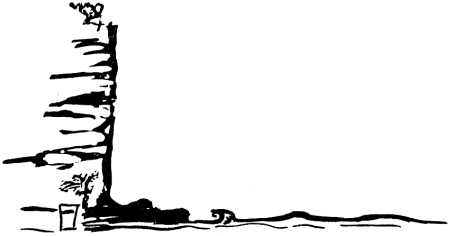
On coastal areas where cliffs fall into a sea a careful search along the lower edges of the cliff will generally disclose soaks or small springs. These in general follow a fault in the rock formation and frequently are evident by a lush growth of ferns and mosses.
Moisture from fish flesh

Another source of liquid sufficient to sustain life at sea, when fresh water has ceased to be available, is from the flesh of fish. The fish are diced, and the small portions of flesh placed in a piece of cotton cloth and the moisture wrung out. This moisture from sea fish is not in itself excessively salty, and can sustain life for a long period.
Condensing salt water
It is possible to condense sea water without equipment and obtain sufficient fresh water for drinking purposes. (See moisture condensation, below).
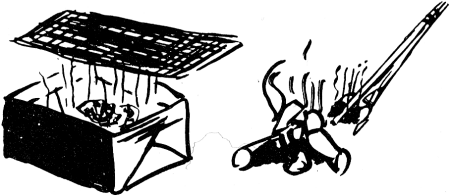
A coolamon is made, or alternatively a hole is scraped in the ground and lined, and the salt water is put into this hole. A fire is built, and stones are put in the fire to heat. These when hot are put in the salt water, which soon boils, and the water vapour is soaked up by a towel or thick mat of cloth. In time, this will literally become saturated, and may be wrung out, yielding a fair quantity of fresh drinkable water. Once the cloth is damp and cool, the collection of water vapour is fairly rapid.
The Solar Still — Moisture condensation in arid areas
A simple still for water condensation in arid areas can be made from a piece of light plastic sheeting, about 4 ft. square. A hole is dug or scooped in the ground in a sunny position. The hole should be about 3' [90 cm] across and 15" to 18" [38 to 45 cm] deep or deeper if possible.
The site should preferably be in moist ground, a depression in a creek bed is ideal if one can be found. If green material such as shrubs or succulent herbage is in the vicinity, the hole should be lined with this and the material packed down. It may be necessary to weigh the material down with a few flat stones.
 In the centre of the hole, and in the deepest part, a billy or container is placed to catch the moisture collected by condensation. In the centre of the hole, and in the deepest part, a billy or container is placed to catch the moisture collected by condensation.
Lay the sheet of plastic to cover the top of the hole, and weigh the edges with stones and use some of the earth scooped from the hole to seal the edges lightly. Place a stone in the centre of the upper side of the plastic sheet above the approximate centre of the water container to weigh it down to just over the container.
Moisture in the soil, and in the greenery placed in the hole will be drawn off by the heat of the sun and condense on the underside of the plastic. Condensation results because the air above the plastic is considerably cooler than the air on the underside of the plastic. The condensed moisture will collect into droplets, coalesce and trickle down the underside to the lowest point where it drops off into the container.
If the underside of the plastic sheet is slightly roughened with fine sandpaper or a similar fine abrasive such as a piece of finely grained stone, the droplets will coalesce and run off more cleanly than if the underside is absolutely smooth. Body waste, such as urine, waste food, moist tea leaves, etc., can be put in the hole. The pure moisture only is condensed.
From one to four or five pints [0.5 to 2 or 2.5 litres] of water a day can be collected by this method. If the stay in the area is likely to be of some duration the top few inches of the hole can be removed and fresh green material replaced and the still will continue to work when this is done. Fresh still sites may be necessary every second or third day.
Acknowledgement: This effective method was first evolved by the Water Conservation Laboratory in Arizona.
How To Purify Stagnant water
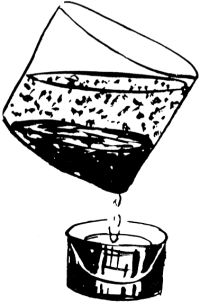 Stagnant water, or water which has become polluted, can be made drinkable and pure without equipment.
Stagnant water, or water which has become polluted, can be made drinkable and pure without equipment.
If time permits, such water can be filtered through a sieve of charcoal.
This will both clarify and to a large extent purify the water, but it is always safer to boil it before drinking. |
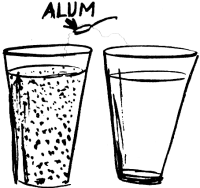 If the water is muddy, the clay particles in flotation in the water can be precipitated by a pinch of alum, which will flocculate and precipitate the particles and so clarify the water. This, however, requires at least 12 hours' wait.
If the water is muddy, the clay particles in flotation in the water can be precipitated by a pinch of alum, which will flocculate and precipitate the particles and so clarify the water. This, however, requires at least 12 hours' wait. |
If no artificial means are available, the polluted or dirty water can be filtered by straining through closely woven garments such as a felt hat or a pair of thick drill trousers. The water, if polluted, can be sterilised by adding hot stones to the water in the filter. The water will soon boil and so made sterile and safe for drinking.
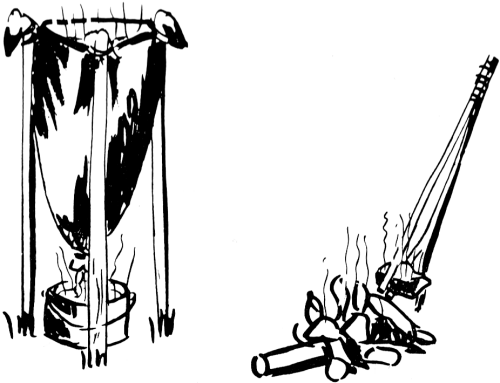
In areas where there is a likelihood of water being infected with bacteria, it is always advisable to boil before drinking or, failing this, to chlorinate the water with a pinch of chloride of lime.
Recommended Reading
|
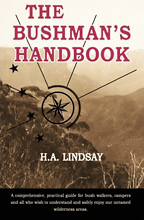 NEW: The Bushman's Handbook, by H. A. Lindsay. This is a really good re-published vintage book about surviving and living in the Australian bush. Vintage books are often better than modern ones, because more people knew and lived these skills back then.
NEW: The Bushman's Handbook, by H. A. Lindsay. This is a really good re-published vintage book about surviving and living in the Australian bush. Vintage books are often better than modern ones, because more people knew and lived these skills back then.
Here's what the Literary Editor of Adelaide's Advertiser newspaper had to say about "The Bushman's Handbook" in late 1948: "If an ordinary city dweller were to be dumped down in the arid central regions of Australia it is fairly certain that if the season was cold he would perhaps survive a few days, but it's also certain that in the heat of summer he would be dead within 48 hours. But the aborigine would be quite at home in such circumstances, which would not be dire straits to him at all. He would know how to find water where apparently none existed, and would unearth sufficient food to enable him to travel safely to better country. The author of "The Bushman's Handbook", who is an expert bushman and descendant of bushmen, and who instructed thousands of Australian and American troops in bushcraft during WWII, here tells exactly how to survive in inhospitable terrain. As to your thirst, he describes how moisture may be obtained from the stems of plants and the limbs of trees - and he shows by illustrations just how the parched outback traveler should proceed. Food can be obtained from all sorts of unlikely sources - for instance, the bilious-looking but tasty and nutritious "witjuti" grubs can be gouged out from the bark of trees. For larger foods the reader is carefully instructed how to make simple but effective snares - to the undoing of rabbits, hares, squirrels and similar game. If you are near streams or pools you have no need to hunger if you follow the Author's instructions and diagrams which will enable you to catch the various kinds of fish without rod, reel or hook. There are also interesting and instructive talks about fire lighting (without matches); the art of camping out; direction finding if you happen to be lost; or how to cord and thatch a shelter for yourself; and on the various special plants and roots which it is safe to eat if driven to extremities. Lastly, the Author gives valuable advice on how to maintain health in the bush, and stresses the value of bushcraft, and the hardiness and self-reliance which it brings, in both peace and war. In all, an admirable and comprehensive bushman's text-book."
Four of the 18 chapters (43 out of 176 pages) are entirely dedicated to finding water in the bush.
Click here to purchase from Amazon Australia
Click here to purchase from Australia (Booktopia) (Probably Unavailable)
Click here to purchase from Australia (Fishpond) (Probably Unavailable)
Click here to purchase from Amazon |
See Also
How to Drain Your Hot Water Heater For Survival Water
Return to Site Map
Share This Page
animals areas birds bushcraft certain drinking eaters finding flesh fluid fresh ground hole moisture plastic tree vegetable version water
Content is copyright © Survival.ark.au 2005-2024 All Rights Reserved. Terms of Use. Definitely read the disclaimer before trying anything from this website, especially including the practices and skills. This website uses affiliate links – this doesn't cost you any more, but I get a commission on purchases made through the website. As an Amazon Associate I earn similarly from qualifying purchases.
|


 Many of the ants require water, and if you see a steady column of small black ants climbing a tree trunk and disappearing into a hole in a crotch it is highly probable that there will be a hidden reservoir of fresh water stored away there.
Many of the ants require water, and if you see a steady column of small black ants climbing a tree trunk and disappearing into a hole in a crotch it is highly probable that there will be a hidden reservoir of fresh water stored away there.  These large, hornet-like creatures are a certain indicator of water. If you see a mason fly's buildings in an area you can be sure that you are within a few hundred yards [metres] of a soak of wet earth.
These large, hornet-like creatures are a certain indicator of water. If you see a mason fly's buildings in an area you can be sure that you are within a few hundred yards [metres] of a soak of wet earth.  All the finches are grain-eaters and water-drinkers. In the dry belts you may see a colony of finches and you can be certain that you are near water, probably a hidden spring or permanent soak.
All the finches are grain-eaters and water-drinkers. In the dry belts you may see a colony of finches and you can be certain that you are near water, probably a hidden spring or permanent soak. Wild pigeons are a reliable indicator of water. Being grain and seed eaters they spend the day out on the plains feeding, and then, with the approach of dusk, make for a waterhole, drink their fill, and fly slowly back to their nesting places.
Wild pigeons are a reliable indicator of water. Being grain and seed eaters they spend the day out on the plains feeding, and then, with the approach of dusk, make for a waterhole, drink their fill, and fly slowly back to their nesting places. All the grain eaters and most of the ground feeders require water, so that if you see their tracks on the ground you can be reasonably certain that there is water within a few miles of your location. An exception to this are parrots and cockatoos, which are not regarded as reliable indicators of water.
All the grain eaters and most of the ground feeders require water, so that if you see their tracks on the ground you can be reasonably certain that there is water within a few miles of your location. An exception to this are parrots and cockatoos, which are not regarded as reliable indicators of water.

 These vegetable "drinking waters" cannot be kept for more than twenty-four hours. The fluid starts to ferment or go bad if stored, and might be dangerous to drink if in this condition.
These vegetable "drinking waters" cannot be kept for more than twenty-four hours. The fluid starts to ferment or go bad if stored, and might be dangerous to drink if in this condition. 




 In the centre of the hole, and in the deepest part, a billy or container is placed to catch the moisture collected by condensation.
In the centre of the hole, and in the deepest part, a billy or container is placed to catch the moisture collected by condensation. Stagnant water, or water which has become polluted, can be made drinkable and pure without equipment.
Stagnant water, or water which has become polluted, can be made drinkable and pure without equipment. If the water is muddy, the clay particles in flotation in the water can be precipitated by a pinch of alum, which will flocculate and precipitate the particles and so clarify the water. This, however, requires at least 12 hours' wait.
If the water is muddy, the clay particles in flotation in the water can be precipitated by a pinch of alum, which will flocculate and precipitate the particles and so clarify the water. This, however, requires at least 12 hours' wait.
